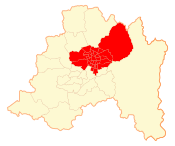Santiago Province (Chile)
|
Santiago Province Provincia de Santiago |
|
|---|---|
| Province | |

Alameda del Libertador Bernardo O'Higgins, a large boulevard in downtown Santiago.
|
|
 Location in the Santiago Metropolitan Region |
|
| Location in Chile | |
| Coordinates: 33°25′S 70°33′W / 33.417°S 70.550°WCoordinates: 33°25′S 70°33′W / 33.417°S 70.550°W | |
| Country | Chile |
| Region | Santiago Metropolitan |
| Capital | Santiago |
| Communes | List of 32 |
| Area | |
| • Total | 2,030.3 km2 (783.9 sq mi) |
| Area rank | 4 |
| Population (2012 Census) | |
| • Total | 4,997,637 |
| • Rank | 1 |
| • Density | 2,500/km2 (6,400/sq mi) |
| Time zone | CLT (UTC−4) |
| • Summer (DST) | CLST (UTC−3) |
| Area code | 56 + 2 |
Santiago Province (Spanish: Provincia de Santiago) is one of the six provinces of the Santiago Metropolitan Region (RM) of central Chile. It encompasses the majority of the population of that region, including 31 of the 36 communities of Greater Santiago. The province spans 2,030.30 km (1,262 mi).
As a province, Santiago is a second-level administrative division of Chile. Unlike all other provinces of Chile, which are governed by a provincial governor appointed by the president, the duties of provincial governor are instead carried out by the intendant of the Santiago Metropolitan Region who is also appointed by the president. In January 2001, the Provincial Delegation of Santiago was created via a Provincial Delegate, who exercises the functions of a provincial governor on behalf of the intendant.
The province comprises 32 communes (Spanish: comunas), each governed by a municipality consisting of an alcalde and municipal council.
The climate of the Santiago Province, and generally of the Metropolitan Region is temperate Mediterranean cold, of the kind called continental. Precipitation is concentrated in the winter months, generally as snow over 1000 m above sea level and, in colder years, over the city of Santiago. Winter tends to be cold with frequent frosts during which temperature drops below 0 °C. The summer months are usually dry and hot. The Cordillera de la Costa acts as a climate screen and reduces marine influence, which makes the climate more continental. This situation becomes apparent when comparing precipitation from a coastal location such as Valparaíso (460 mm) with that of Santiago de Chile (360 mm).
...
Wikipedia

